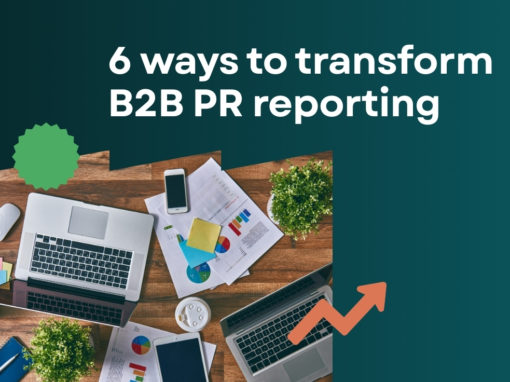Work in PR and comms wondering what 2026 has in store? While we don’t have a crystal ball, (we’d have predicted the Lotto numbers if we did!), we do have a few predictions on the future of PR and what you can expect to see.
In no particular order, the key trends that will shape comms and PR in 2026 include:
Showing the business impact of PR will continue to be critical.
PR teams will need to demonstrate tangible, data-driven ROI. Whether the goal is to increase brand awareness, build trust, differentiate in the market, or calm a crisis, PR pros must show clear evidence that PR drives outcomes if they want to get stakeholders onside and secure budget approval.
The shift to value-based metrics rather than vanity metrics will continue too. 2026 will also be the year that we banish AVE to the history books once and for all. Attention metrics will take centre stage instead. After all, Attention Earned and Attention Cost Estimates (ACE) help PR pros tell a much better story than AVE.
ACE: The credible alternative to AVE that we’ve all been waiting for
Comparison analysis, which used to be a nice-to-have, will also become a permanent fixture in PR reporting. Comparing datasets, whether across time, tiers, regions or campaigns, unlocks much deeper insights for powerful storytelling and compelling narratives.
For example, what would you rather tell your clients (or C-suite if you’re in-house)? That you secured 30 pieces of coverage in Q4 or that you secured 30, an increase of 45% on the previous quarter with a 60% rise in key message penetration?
Comparison data also enables agility, as it gives PR teams the opportunity to optimise or pivot at speed. If you’re not already providing hard-hitting evidence of the ROI PR brings, don’t panic, but don’t delay!
With the right PR reporting platform (like Releasd, sorry for the shameless plug), you can streamline your PR reporting processes (and implement things like attention metrics and comparison data to name a few) to show the real progress you’ve made.
AI will become more of a strategic partner.
Many PR pros dipped a somewhat tentative toe into the world of AI in 2025, but we expect the use of AI to accelerate in 2026, going from assistant to more of a strategic partner. Don’t just take our word for it though. A global study from Protiviti found that more than 68% of organisations will have integrated autonomous or semi-autonomous AI agents into their core operations by 2026.
So what is the future of PR when it comes to AI? What will PR teams use AI agents for? Well, quite a few things but we reckon one of the most popular will be sentiment analysis. AI agents can, for instance, scan vast amounts of media coverage and social conversations in real-time. We know that PR teams have already been using agents to help draft and optimise content and we expect more to follow suit in the new year.
Agentic AI adoption will also rise thanks to the many benefits it brings. If you plan to implement AI agents or agentic AI in 2026, our advice is to take your time. Don’t rush when it comes to choosing platforms and ensure those that make your shortlist comply with regulations and are ethically sound. Better still, see if you can get a free trial – that way you can see if the platform meets your unique needs before you sign on the dotted line and part with your cash.
Goodbye static press releases. Hello visually rich assets.
Press releases will evolve (fairly dramatically) in 2026 to reflect the rise of advanced PR tech, changing media habits and, you guessed it, AI. Firstly, the structure will change. It’s not just humans reading them anymore. AI reads, or should I say, scans, them too. We’ll see a lot more Q&A sections and schema markups in press releases to help AI search engines crawl, summarise and syndicate stories at speed.
Static blocks of text will be replaced by visually rich assets too. Us comms professionals have long incorporated video clips and infographics into press releases, but they’ll become mandatory rather than optional. And we expect PR pros to embed AR and even real-time analytics dashboards as well to make it easier for journalists to extract the data points needed for their stories.
Thinking outside the box. Immersive and phygital campaigns will grow in popularity.
The number of immersive PR campaigns will likely rise in 2026, especially when you consider 56% of UK companies have adopted some form of immersive technology, according to government research.
Forward-thinking PR and comms teams, especially those in retail, tech, and healthcare, have already successfully integrated immersive elements, such as AR (augmented reality, VR (virtual reality) and phygital campaigns (when PR teams blend physical, real-world experiences with digital technology within their PR strategies) and we expect adoption rates to climb over next 12 months. We’re quite excited about this one actually!
Niche influencers and publications will take a bigger bite of the (smaller) cherry.
Mainstream media continued to contract in 2025 with major outlets like ITV, Reach and Business Insider among those announcing layoffs. PR strategies will adapt further and more prominence will be given to influencers, niche publications, podcasts and so on, as a result. Relationship building will be key and PR specialists will need to make sure they bring together all media coverage regardless of platform and format when compiling PR reports too.
We recommend you also provide some context as well to educate your stakeholders on the shift from mainstream media to more niche titles. It’s obvious to us PR and comms pros, but likely isn’t to those who don’t live and breathe PR day in, day out.
Freelance and fractional PR roles will increase.
Business cycles are a lot shorter than they used to be. Fact. They’re also way more unpredictable because of geopolitical tensions, economic pressures and the ever-evolving technology landscape. Business planning has become way more complex and workforces have shrunk as a result.
And while there’s no one source of truth, estimates suggest layoffs of between 30,000 and 40,000 in marketing and comms alone in 2025. More organisations are, however, opting to use freelance and fractional workers. In fact, marketing and communications account for 34% of all fractional workforce roles, according to the FRAK 2025 State of Fractional Report. This shift highlights the growing importance of flexible work models when navigating an unpredictable global landscape.
There’ll be a lot of change in 2026 for us PR pros, but those who are willing to adapt will reap the rewards. So, get ready to ditch the old, embrace the new and show everyone the real impact of PR.
Struggling to demonstrate PR value? The Releasd platform streamlines PR reporting, helping you showcase activity, results and impact in one place. See how it works with the video below or schedule a demo.



